Synergistic Effect of Polymorphs in Doped NaNi0.5Mn0.5O2 Cathode Material for Improving Electrochemical Performances in Na-Batteries
Abstract
:1. Introduction
2. Materials and Methods
2.1. Synthesis
2.2. Instruments
3. Results and Discussion
3.1. X-ray Powder Diffraction
3.2. Scanning Electron Microscopy
3.3. Cyclic Voltammetry (CV)
3.4. Charge–Discharge Measurements
3.5. Ex-Situ XRPD Analysis
4. Conclusions
Supplementary Materials
Author Contributions
Funding
Institutional Review Board Statement
Informed Consent Statement
Data Availability Statement
Acknowledgments
Conflicts of Interest
References
- Kubota, K.; Kumakura, S.; Yoda, Y.; Kuroki, K.; Komaba, S. Electrochemistry and Solid-State Chemistry of NaMeO2. Adv. Energy Mater. 2018, 8, 1703415. [Google Scholar] [CrossRef]
- Yabuuchi, N.; Kubota, K.; Dahbi, M.; Komaba, S. Research Development on Sodium-Ion Batteries. Chem. Rev. 2014, 114, 11636–11682. [Google Scholar] [CrossRef]
- Li, L.; Zheng, Y.; Zhang, S.; Yang, J.; Shao, Z.; Guo, Z. Recent progress on sodium ion batteries:potential high-performance anodes. Energy Environ. Sci. 2018, 11, 2310–2340. [Google Scholar] [CrossRef] [Green Version]
- Delmas, C.; Fouassier, C.; Hagenmuller, P. Structural classification and properties of the layered oxides. Phys. B 1980, 99, 81–85. [Google Scholar] [CrossRef]
- Lee, D.H.; Xuz, J.; Meng, Y.S. An advanced cathode for Na-ion batteries with high rate and excellent structural stability. Phys. Chem. Chem. Phys. 2013, 15, 3304–3312. [Google Scholar] [CrossRef]
- Wang, S.; Sun, C.; Wang, N.; Zhang, Q. Ni- and/or Mn-based layered transition metal oxides as cathode materials for sodium ion batteries: Status, challenges and countermeasures. J. Mater. Chem. A 2019, 7, 10138–10158. [Google Scholar] [CrossRef]
- Sun, Y.; Guo, S.; Zhou, H. Exploration of Advanced Electrode Materials for Rechargeable Sodium-Ion Batteries. Adv. Energy Mater. 2019, 9, 1800212. [Google Scholar] [CrossRef]
- Komaba, S.; Nakayama, T.; Ogata, A.; Shimizu, T.; Takei, C.; Takada, S.; Hokura, A.; Nakai, I. Electrochemically Reversible Sodium Intercalation of Layered NaNi0.5Mn0.5O2 and NaCrO2. ECS Trans. 2009, 16, 43–55. [Google Scholar] [CrossRef]
- Sathiya, M.; Jacquet, Q.; Doublet, M.L.; Karakulina, O.M.; Hadermann, J.; Tarascon, J.M. A Chemical Approach to Raise Cell Voltage and Suppress Phase Transition in O3 Sodium Layered Oxide Electrodes. Adv. Energy Mater. 2018, 8, 1702599. [Google Scholar] [CrossRef]
- Deng, J.; Luo, W.B.; Lu, X.; Yao, Q.; Wang, Z.; Liu, H.K.; Zhou, H.; Dou, S.X. High Energy Density Sodium-Ion Battery with Industrially Feasible and Air-Stable O3-Type Layered Oxide Cathode. Adv. Energy Mater. 2018, 8, 1701610. [Google Scholar] [CrossRef]
- Leng, M.; Bi, J.; Wang, W.; Xing, Z.; Yan, W.; Gao, X.; Wang, J.; Liu, R. Superior electrochemical performance of O3-type NaNi0.5-xMn0.3Ti0.2ZrxO2 cathode material for sodium-ion batteries from Ti and Zr substitution of the transition metals. J. Alloys Comp. 2020, 816, 152581. [Google Scholar] [CrossRef]
- Yuan, D.D.; Wang, Y.X.; Cao, Y.L.; Ai, X.P.; Yang, X.H. Improved Electrochemical Performance of Fe-Substituted NaNi0.5Mn0.5O2 Cathode Materials for Sodium-Ion Batteries. ACS Appl. Mater. Interfaces 2015, 7, 8585–8591. [Google Scholar] [CrossRef]
- Wang, Q.; Mariyappan, S.; Vergnet, J.; Abakumov, A.M.; Rousse, G.; Rabuel, F.; Chakir, M.; Tarascon, J.M. Reaching the Energy Density Limit of Layered O3-NaNi0.5Mn0.5O2 Electrodes via Dual Cu and Ti Substitution. Adv. Energy Mater. 2019, 9, 1901785. [Google Scholar] [CrossRef]
- Yu, Y.; Kong, W.; Li, Q.; Ning, D.; Schuck, G.; Schumacher, G.; Su, C.; Liu, X. Understanding the Multiple Effects of TiO2 Coating on NaMn0.33Fe0.33Ni0.33O2 Cathode Material for Na-Ion Batteries. ACS Appl. Energy Mater. 2020, 3, 933–942. [Google Scholar] [CrossRef] [Green Version]
- Hwang, J.Y.; Yu, T.Y.; Sun, Y.K. Simultaneous MgO coating and Mg doping of Na[Ni0.5Mn0.5]O2 cathode: Facile and customizable approach to high-voltage sodium-ion batteries. J. Mater. Chem. A 2018, 6, 16854–16863. [Google Scholar] [CrossRef]
- Zhou, C.; Yang, L.; Zhou, C.; Lu, B.; Liu, J.; Ouyang, L.; Hu, R.; Liu, J.; Zhu, M. Co-Substitution Enhances the Rate Capability and Stabilizes the Cyclic Performance of O3-Type Cathode NaNi0.45−xMn0.25Ti0.3CoxO2 for Sodium-Ion Storage at High Voltage. ACS Appl. Mater. Interfaces 2019, 11, 7906–7913. [Google Scholar] [CrossRef] [PubMed]
- Yu, T.Y.; Hwang, J.Y.; Bae, I.T.; Jung, H.G.; Sun, Y.K. High-performance Ti-doped O3-type Na[Tix(Ni0.6Co0.2Mn0.2)1-x]O2 cathodes for practical sodium-ion batteries. J. Pow. Sour. 2019, 422, 1–8. [Google Scholar] [CrossRef]
- Mao, Q.; Zhang, C.; Yang, W.; Yang, J.; Sun, L.; Hao, Y.; Liu, X. Mitigating the voltage fading and lattice cell variations of O3-NaNi0.2Fe0.35Mn0.45O2 for high performance Na-ion battery cathode by Zn doping. J. Alloys Comp. 2019, 794, 509–517. [Google Scholar] [CrossRef]
- Xu, G.L.; Amine, R.; Xu, Y.F.; Liu, J.; Gim, J.; Ma, T.; Ren, Y.; Sun, C.J.; Liu, Y.; Zhang, X.; et al. Insights into the structural effects of layered cathode materials for high voltage sodium-ion batteries. Energy Environ. Sci. 2017, 10, 1677–1693. [Google Scholar] [CrossRef]
- Van Nguyen, H.; Ngoc Nguyen, H.T.; Le Thanh Huynh, N.; Le Bao Phan, A.; Van Tran, M.; My Loan Le, P. A study of the electrochemical kinetics of sodium intercalation in P2/O1/O3-NaNi1/3Mn1/3Co1/3O2. J. Solid State Electrochem. 2020, 24, 57–67. [Google Scholar] [CrossRef]
- Bruker AXS. TOPAS V3.0: General profile and structural analysis software for powder diffraction data. In User Manual Bruker AXS; Bruker AXS: Karlsruhe, Germany, 2005. [Google Scholar]
- Nuti, M.; Spada, D.; Quinzeni, I.; Capelli, S.; Albini, B.; Galinetto, P.; Bini, M. From tunnel NMO to layered polymorphs oxides for sodium ion batteries. SN Appl. Sci. 2020, 2, 1893. [Google Scholar] [CrossRef]
- Wang, P.F.; Yao, H.R.; Liu, X.Y.; Zhang, J.N.; Gu, L.; Yu, X.Q.; Yin, X.Y.; Guo, Y.G. Ti-Substituted NaNi0.5Mn0.5-xTixO2 Cathodes with Reversible O3−P3 Phase Transition for High-Performance Sodium-Ion Batteries. Adv. Mater. 2017, 29, 1700210. [Google Scholar] [CrossRef]
- Augustyn, V.; Simon, P.; Dunn, B. Pseudocapacitive oxide materials for high-rate electrochemical energy storage. Energy Environ. Sci. 2014, 7, 1597–1614. [Google Scholar] [CrossRef] [Green Version]
- Ali, G.A.M.; Wahba, O.A.G.; Hassan, A.M.; Fouad, O.A.; Chong, K.F. Calcium-based nanosized mixed metal oxides for supercapacitor application. Ceram. Int. 2015, 41, 8230–8234. [Google Scholar] [CrossRef] [Green Version]
- Thalji, M.R.; Ali, G.A.M.; Algarni, H.; Chong, K.F. Al3+ ion intercalation pseudocapacitance study of W18O49 nanostructure. J. Power Sources 2019, 438, 227028. [Google Scholar] [CrossRef]
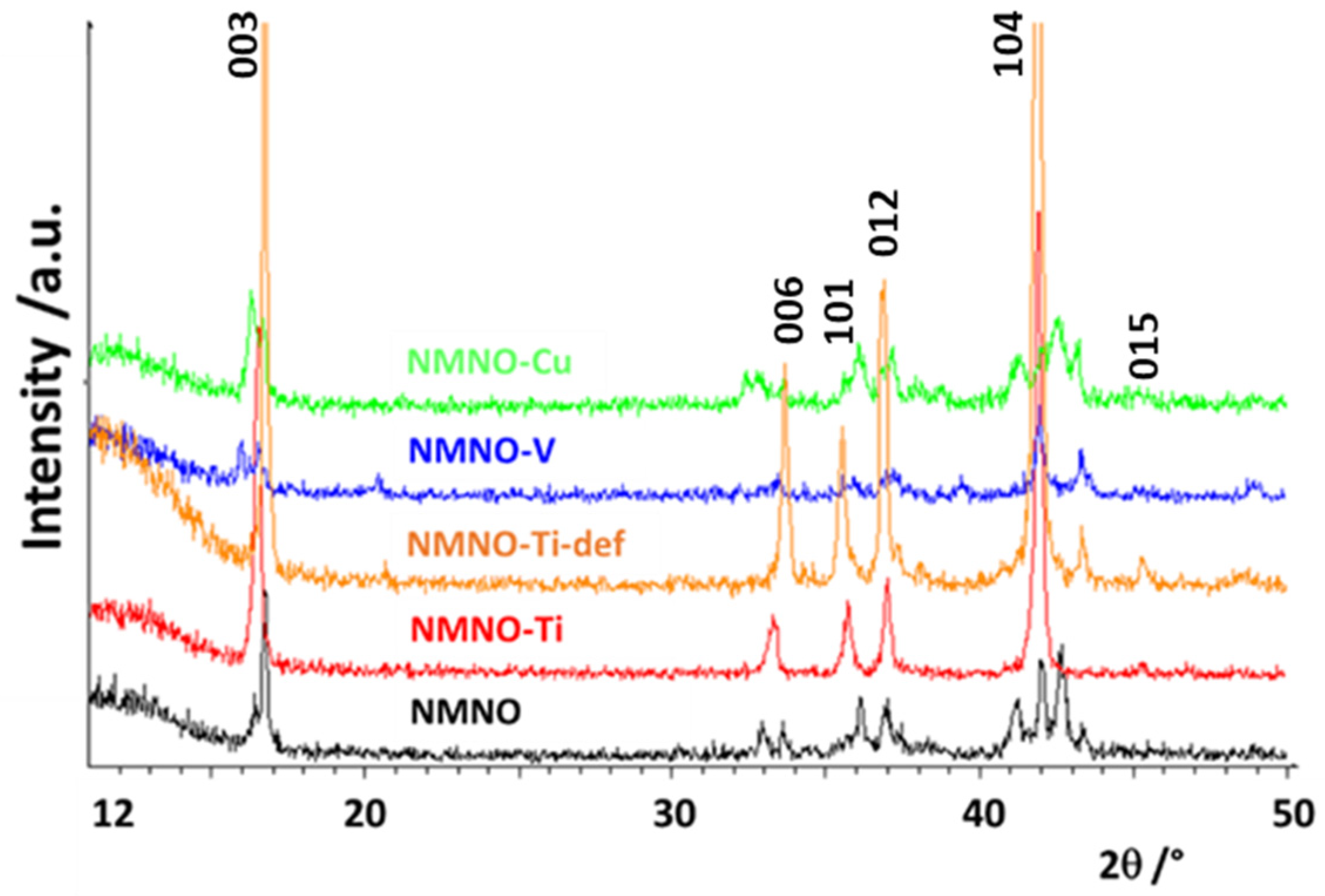
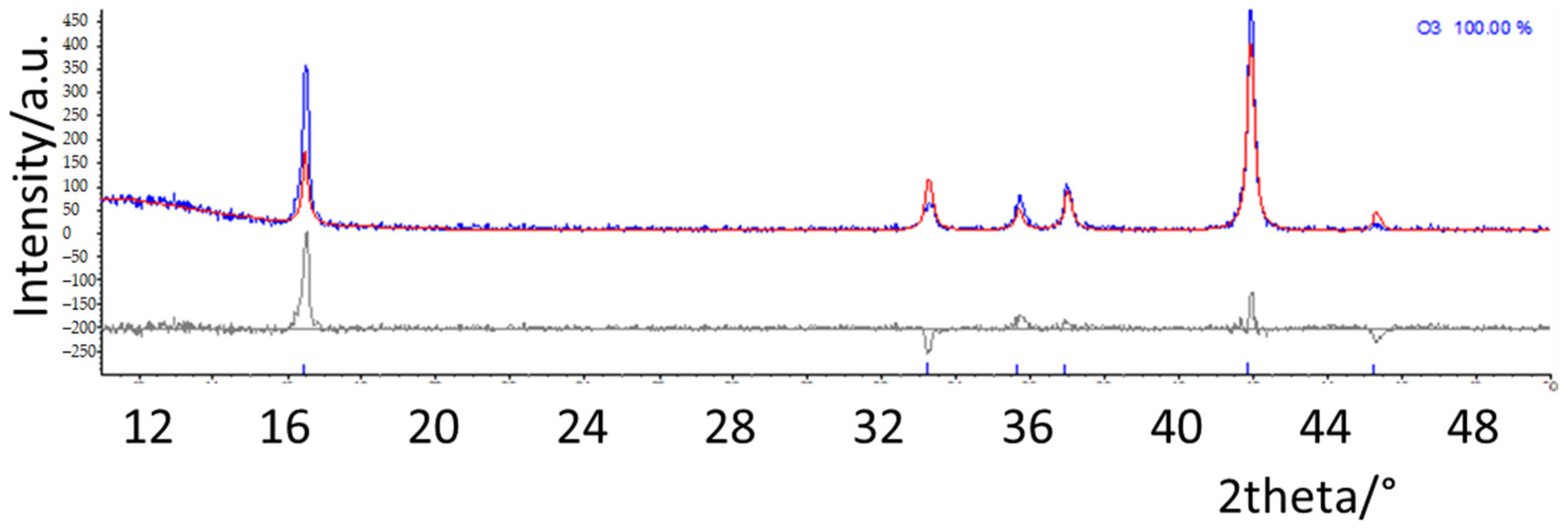

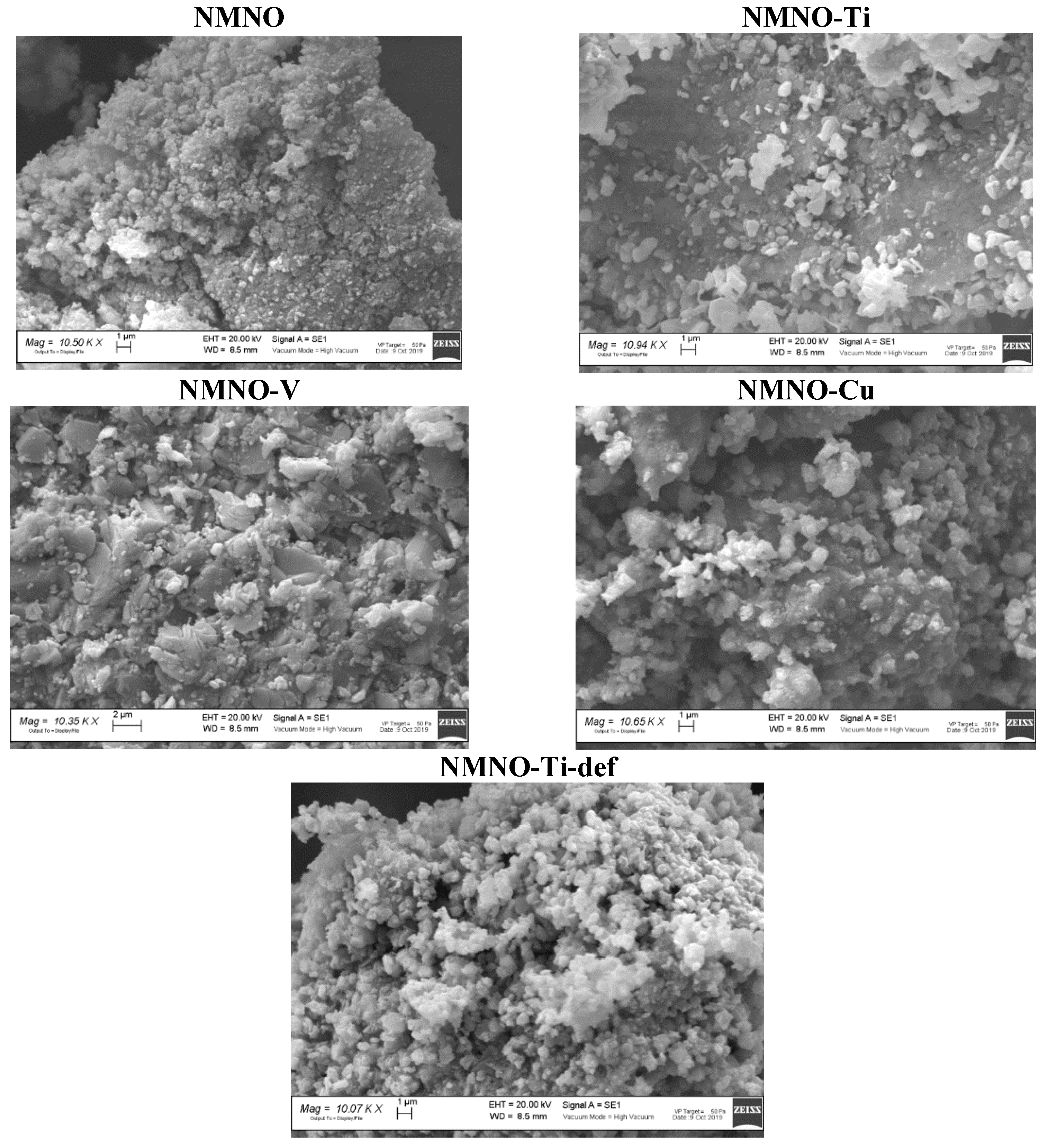
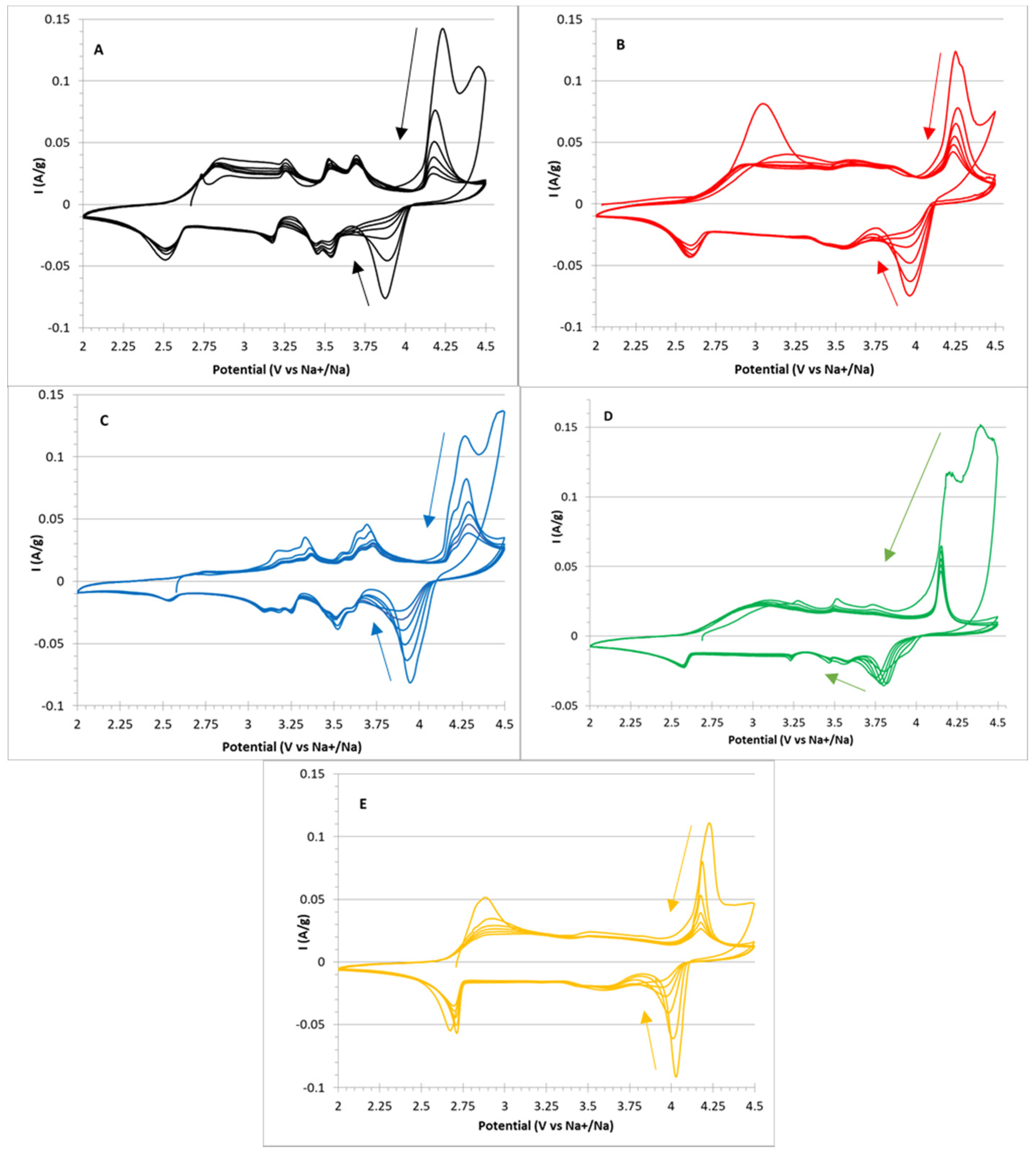
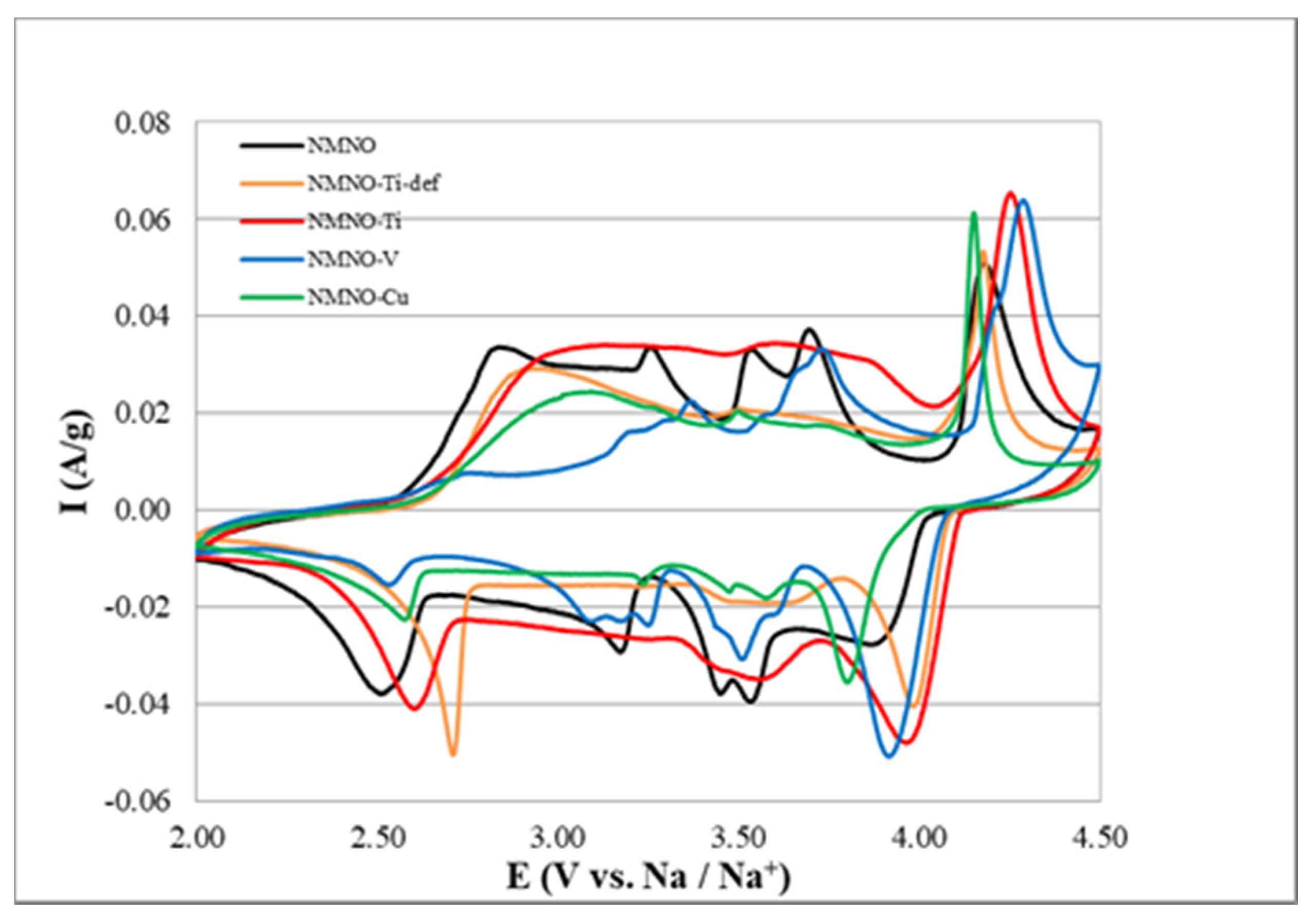
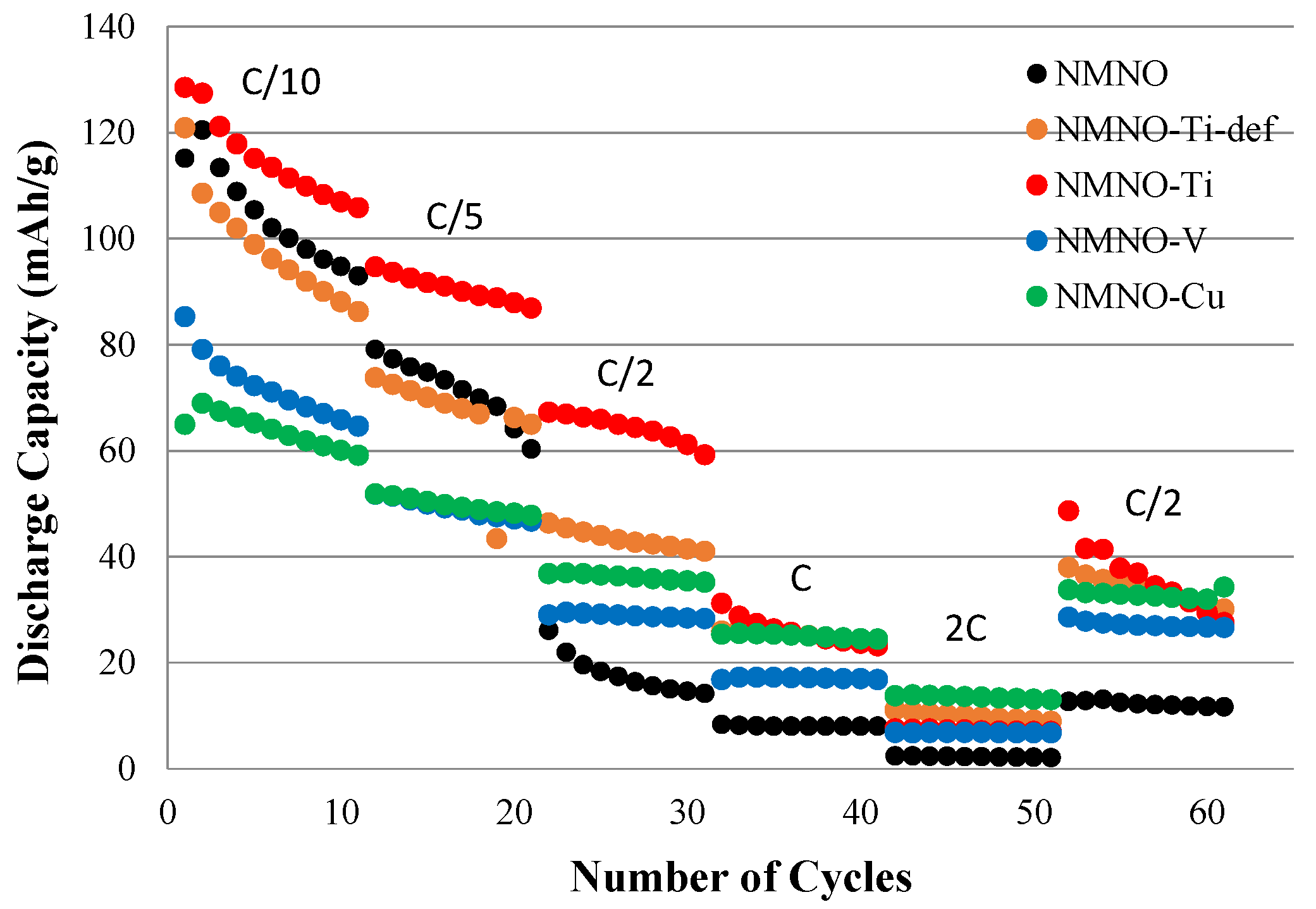
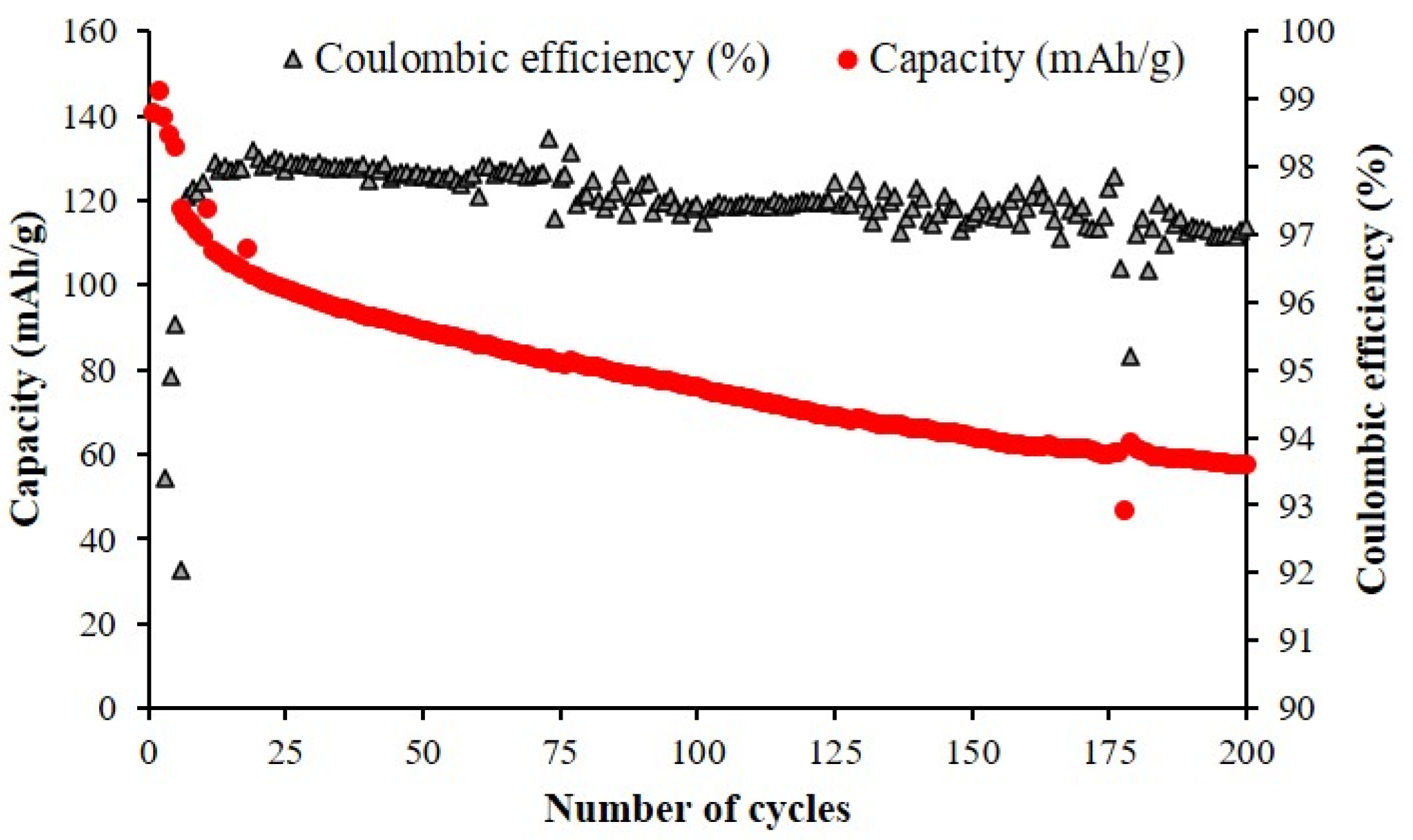
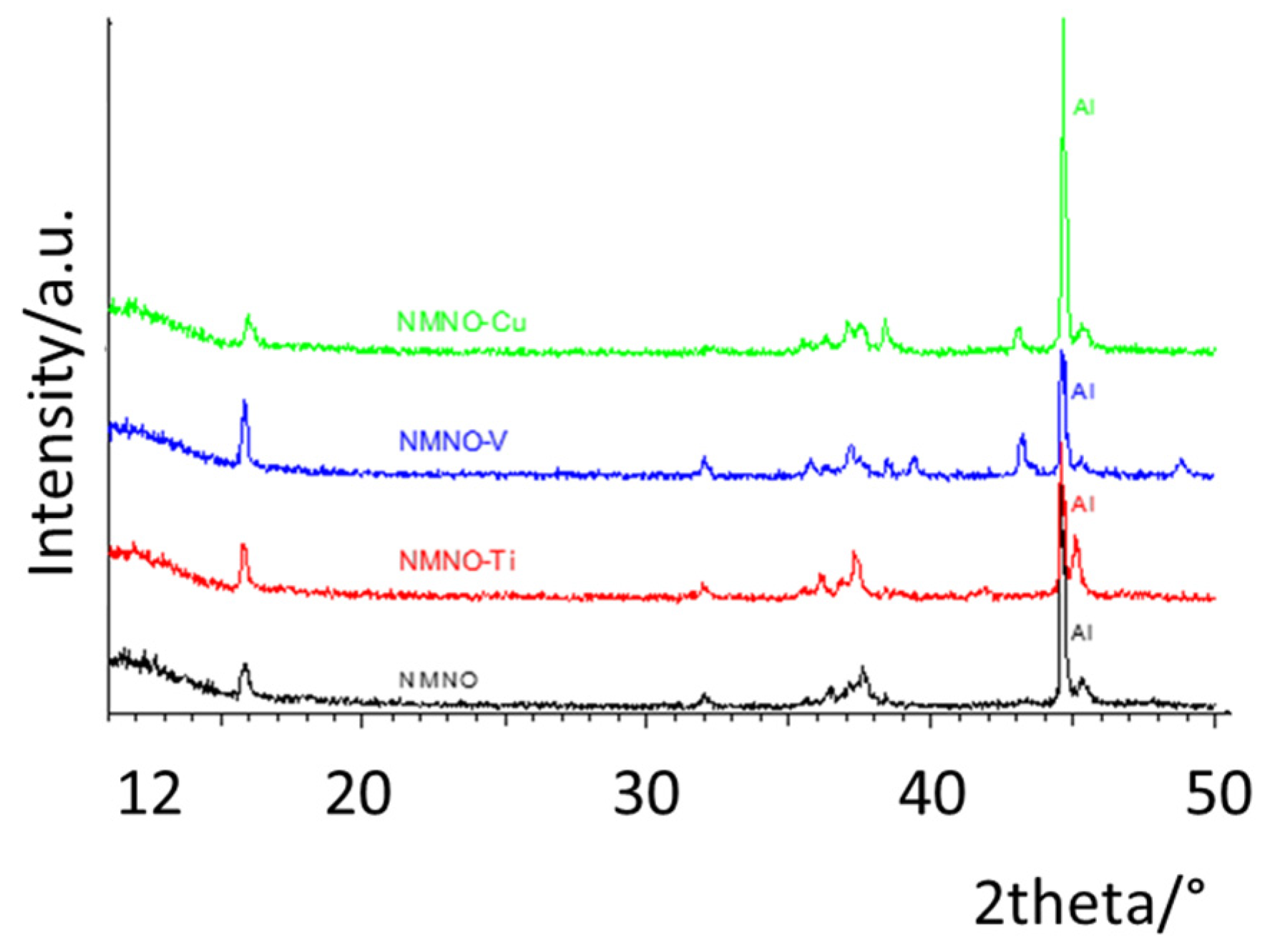
| Elements (Atomic %) Sample | Na | Mn | Ni | Dopant |
|---|---|---|---|---|
| NMNO | 23.11 | 11.32 | 10.91 | – |
| NMNO-Ti | 19.32 | 8.57 | 8.50 | 2.09 |
| NMNO-Ti-def | 19.21 | 7.98 | 8.95 | 1.88 |
| NMNO-Cu | 21.03 | 9.34 | 9.42 | 2.21 |
| NMNO-V | 20.54 | 9.12 | 9.22 | 2.15 |
Publisher’s Note: MDPI stays neutral with regard to jurisdictional claims in published maps and institutional affiliations. |
© 2021 by the authors. Licensee MDPI, Basel, Switzerland. This article is an open access article distributed under the terms and conditions of the Creative Commons Attribution (CC BY) license (https://creativecommons.org/licenses/by/4.0/).
Share and Cite
Leccardi, F.; Nodari, D.; Spada, D.; Ambrosetti, M.; Bini, M. Synergistic Effect of Polymorphs in Doped NaNi0.5Mn0.5O2 Cathode Material for Improving Electrochemical Performances in Na-Batteries. Electrochem 2021, 2, 335-346. https://doi.org/10.3390/electrochem2020024
Leccardi F, Nodari D, Spada D, Ambrosetti M, Bini M. Synergistic Effect of Polymorphs in Doped NaNi0.5Mn0.5O2 Cathode Material for Improving Electrochemical Performances in Na-Batteries. Electrochem. 2021; 2(2):335-346. https://doi.org/10.3390/electrochem2020024
Chicago/Turabian StyleLeccardi, Francesco, Davide Nodari, Daniele Spada, Marco Ambrosetti, and Marcella Bini. 2021. "Synergistic Effect of Polymorphs in Doped NaNi0.5Mn0.5O2 Cathode Material for Improving Electrochemical Performances in Na-Batteries" Electrochem 2, no. 2: 335-346. https://doi.org/10.3390/electrochem2020024







